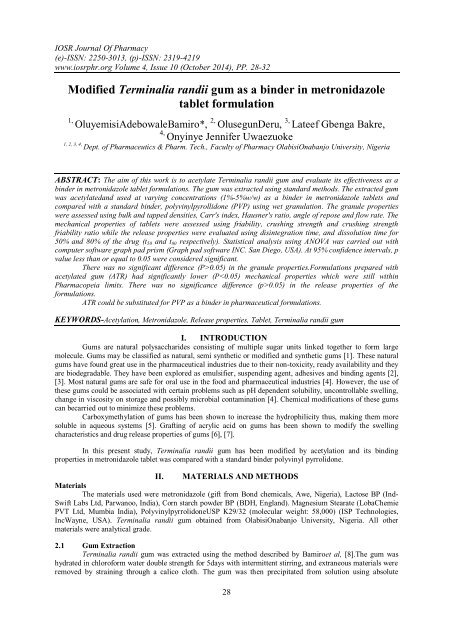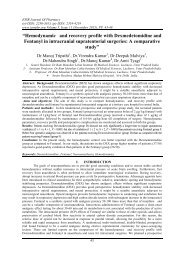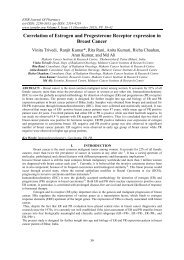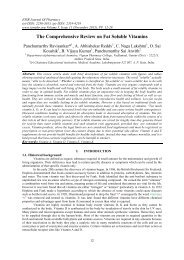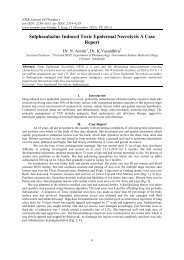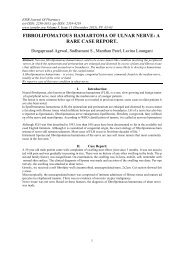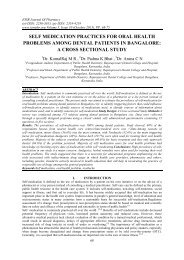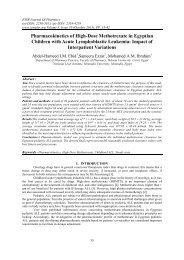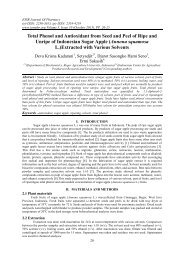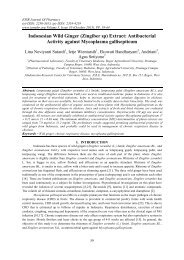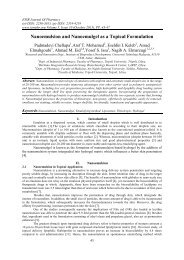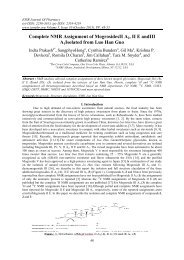Modified Terminalia randii gum as a binder in metronidazole tablet formulation
You also want an ePaper? Increase the reach of your titles
YUMPU automatically turns print PDFs into web optimized ePapers that Google loves.
IOSR Journal Of Pharmacy<br />
(e)-ISSN: 2250-3013, (p)-ISSN: 2319-4219<br />
www.iosrphr.org Volume 4, Issue 10 (October 2014), PP. 28-32<br />
<strong>Modified</strong> <strong>Term<strong>in</strong>alia</strong> <strong>randii</strong> <strong>gum</strong> <strong>as</strong> a <strong>b<strong>in</strong>der</strong> <strong>in</strong> <strong>metronidazole</strong><br />
<strong>tablet</strong> <strong>formulation</strong><br />
1,<br />
OluyemisiAdebowaleBamiro*, 2, OlusegunDeru, 3, Lateef Gbenga Bakre,<br />
4,<br />
Ony<strong>in</strong>ye Jennifer Uwaezuoke<br />
1, 2, 3, 4,<br />
Dept. of Pharmaceutics & Pharm. Tech., Faculty of Pharmacy OlabisiOnabanjo University, Nigeria<br />
ABSTRACT: The aim of this work is to acetylate <strong>Term<strong>in</strong>alia</strong> <strong>randii</strong> <strong>gum</strong> and evaluate its effectiveness <strong>as</strong> a<br />
<strong>b<strong>in</strong>der</strong> <strong>in</strong> <strong>metronidazole</strong> <strong>tablet</strong> <strong>formulation</strong>s. The <strong>gum</strong> w<strong>as</strong> extracted us<strong>in</strong>g standard methods. The extracted <strong>gum</strong><br />
w<strong>as</strong> acetylatedand used at vary<strong>in</strong>g concentrations (1%-5%w/w) <strong>as</strong> a <strong>b<strong>in</strong>der</strong> <strong>in</strong> <strong>metronidazole</strong> <strong>tablet</strong>s and<br />
compared with a standard <strong>b<strong>in</strong>der</strong>, polyv<strong>in</strong>ylpyrollidone (PVP) us<strong>in</strong>g wet granulation. The granule properties<br />
were <strong>as</strong>sessed us<strong>in</strong>g bulk and tapped densities, Carr's <strong>in</strong>dex, Hausner's ratio, angle of repose and flow rate. The<br />
mechanical properties of <strong>tablet</strong>s were <strong>as</strong>sessed us<strong>in</strong>g friability, crush<strong>in</strong>g strength and crush<strong>in</strong>g strength<br />
friability ratio while the rele<strong>as</strong>e properties were evaluated us<strong>in</strong>g dis<strong>in</strong>tegration time, and dissolution time for<br />
50% and 80% of the drug (t 50 and t 80 respectively). Statistical analysis us<strong>in</strong>g ANOVA w<strong>as</strong> carried out with<br />
computer software graph pad prism (Graph pad software INC. San Diego, USA). At 95% confidence <strong>in</strong>tervals, p<br />
value less than or equal to 0.05 were considered significant.<br />
There w<strong>as</strong> no significant difference (P>0.05) <strong>in</strong> the granule properties.Formulations prepared with<br />
acetylated <strong>gum</strong> (ATR) had significantly lower (P0.05) <strong>in</strong> the rele<strong>as</strong>e properties of the<br />
<strong>formulation</strong>s.<br />
ATR could be substituted for PVP <strong>as</strong> a <strong>b<strong>in</strong>der</strong> <strong>in</strong> pharmaceutical <strong>formulation</strong>s.<br />
KEYWORDS-Acetylation, Metronidazole, Rele<strong>as</strong>e properties, Tablet, <strong>Term<strong>in</strong>alia</strong> <strong>randii</strong> <strong>gum</strong><br />
I. INTRODUCTION<br />
Gums are natural polysaccharides consist<strong>in</strong>g of multiple sugar units l<strong>in</strong>ked together to form large<br />
molecule. Gums may be cl<strong>as</strong>sified <strong>as</strong> natural, semi synthetic or modified and synthetic <strong>gum</strong>s [1]. These natural<br />
<strong>gum</strong>s have found great use <strong>in</strong> the pharmaceutical <strong>in</strong>dustries due to their non-toxicity, ready availability and they<br />
are biodegradable. They have been explored <strong>as</strong> emulsifier, suspend<strong>in</strong>g agent, adhesives and b<strong>in</strong>d<strong>in</strong>g agents [2],<br />
[3]. Most natural <strong>gum</strong>s are safe for oral use <strong>in</strong> the food and pharmaceutical <strong>in</strong>dustries [4]. However, the use of<br />
these <strong>gum</strong>s could be <strong>as</strong>sociated with certa<strong>in</strong> problems such <strong>as</strong> pH dependent solubility, uncontrollable swell<strong>in</strong>g,<br />
change <strong>in</strong> viscosity on storage and possibly microbial contam<strong>in</strong>ation [4]. Chemical modifications of these <strong>gum</strong>s<br />
can becarried out to m<strong>in</strong>imize these problems.<br />
Carboxymethylation of <strong>gum</strong>s h<strong>as</strong> been shown to <strong>in</strong>cre<strong>as</strong>e the hydrophilicity thus, mak<strong>in</strong>g them more<br />
soluble <strong>in</strong> aqueous systems [5]. Graft<strong>in</strong>g of acrylic acid on <strong>gum</strong>s h<strong>as</strong> been shown to modify the swell<strong>in</strong>g<br />
characteristics and drug rele<strong>as</strong>e properties of <strong>gum</strong>s [6], [7].<br />
In this present study, <strong>Term<strong>in</strong>alia</strong> <strong>randii</strong> <strong>gum</strong> h<strong>as</strong> been modified by acetylation and its b<strong>in</strong>d<strong>in</strong>g<br />
properties <strong>in</strong> <strong>metronidazole</strong> <strong>tablet</strong> w<strong>as</strong> compared with a standard <strong>b<strong>in</strong>der</strong> polyv<strong>in</strong>yl pyrrolidone.<br />
II. MATERIALS AND METHODS<br />
Materials<br />
The materials used were <strong>metronidazole</strong> (gift from Bond chemicals, Awe, Nigeria), Lactose BP (Ind-<br />
Swift Labs Ltd, Parwanoo, India), Corn starch powder BP (BDH, England). Magnesium Stearate (LobaChemie<br />
PVT Ltd, Mumbia India), Polyv<strong>in</strong>ylpyrrolidoneUSP K29/32 (molecular weight: 58,000) (ISP Technologies,<br />
IncWayne, USA). <strong>Term<strong>in</strong>alia</strong> <strong>randii</strong> <strong>gum</strong> obta<strong>in</strong>ed from OlabisiOnabanjo University, Nigeria. All other<br />
materials were analytical grade.<br />
2.1 Gum Extraction<br />
<strong>Term<strong>in</strong>alia</strong> <strong>randii</strong> <strong>gum</strong> w<strong>as</strong> extracted us<strong>in</strong>g the method described by Bamiroet al, [8].The <strong>gum</strong> w<strong>as</strong><br />
hydrated <strong>in</strong> chloroform water double strength for 5days with <strong>in</strong>termittent stirr<strong>in</strong>g, and extraneous materials were<br />
removed by stra<strong>in</strong><strong>in</strong>g through a calico cloth. The <strong>gum</strong> w<strong>as</strong> then precipitated from solution us<strong>in</strong>g absolute<br />
28
<strong>Modified</strong> term<strong>in</strong>alia <strong>randii</strong> <strong>gum</strong> <strong>as</strong> a <strong>b<strong>in</strong>der</strong> <strong>in</strong> <strong>metronidazole</strong> <strong>tablet</strong> <strong>formulation</strong><br />
ethanol. The precipitated <strong>gum</strong> w<strong>as</strong> filtered w<strong>as</strong>hed with diethyl ether and then dried <strong>in</strong> a hot air oven at 40 o C for<br />
24 hours. The purified <strong>gum</strong> w<strong>as</strong> then pulverized and packed <strong>in</strong> an airtight conta<strong>in</strong>er.<br />
2.2 Acetylation of <strong>Term<strong>in</strong>alia</strong> <strong>randii</strong> <strong>gum</strong><br />
Extracted <strong>gum</strong> (10g) w<strong>as</strong> dispersed <strong>in</strong> 100ml of distilled water with constant stirr<strong>in</strong>gfor 30m<strong>in</strong>s.The<br />
slurry w<strong>as</strong> adjusted to pH 8.0 with NaOH. 1.2g of acetic anhydride w<strong>as</strong> added to the slurry and the reaction w<strong>as</strong><br />
allowed to proceed for another 5 m<strong>in</strong>utes. The pH of the slurry w<strong>as</strong> adjusted to 4.5 with 0.5M HCL and then<br />
filtered through Wathman filter 1 paper. The residue w<strong>as</strong> thoroughly w<strong>as</strong>hed with distilled water to completely<br />
remove some acid that may be present <strong>in</strong> the product and f<strong>in</strong>ally air dried at room temperature. The acetylated<br />
<strong>gum</strong> w<strong>as</strong> characterised us<strong>in</strong>g Fourier Transform Infrared Spectroscopy (FTIR).<br />
2.3 FTIR of acetylated and natural <strong>Term<strong>in</strong>alia</strong> <strong>gum</strong><br />
The FTIR spectrum of the <strong>gum</strong> w<strong>as</strong> recorded with a Perk<strong>in</strong> Elmer RXI spectrophotometer<br />
(Connecticut, USA). The dry <strong>gum</strong> powder w<strong>as</strong> mixed with pot<strong>as</strong>sium bromide (KBr) and pressed <strong>in</strong>to pellets.<br />
The spectrum w<strong>as</strong> obta<strong>in</strong>ed by scann<strong>in</strong>g between 4000 and 500cm -1<br />
2.4 Tablet Preparation<br />
100g batch sizes were prepared conta<strong>in</strong><strong>in</strong>g 60 % w/w <strong>metronidazole</strong> (drug), 30 % w/w lactose (diluent)<br />
and 10% w/w corn starch (dis<strong>in</strong>tegrant). Metronidazole granules were prepared us<strong>in</strong>g wet granulation method.<br />
Acetylated <strong>Term<strong>in</strong>alia</strong> <strong>gum</strong> (ATR) w<strong>as</strong> used <strong>as</strong> a <strong>b<strong>in</strong>der</strong> at different concentrations (1-5 % w/w), while PVP w<strong>as</strong><br />
used <strong>as</strong> a standard. The granule properties of the granules were evaluated us<strong>in</strong>g USP 2007 methods. The<br />
granules were compressed on a Carvierhydraulic mach<strong>in</strong>e (Model C, Carver Inc., Menomonee Falls, WI) with<br />
predeterm<strong>in</strong>ed load for 30 seconds. The <strong>tablet</strong>s were stored <strong>in</strong> air tight conta<strong>in</strong>ers for 24 hours to allow for<br />
el<strong>as</strong>tic recovery.<br />
2.5 Tablet properties<br />
Friability w<strong>as</strong> determ<strong>in</strong>ed with a DBK friabilator test apparatus (Mumbai, India) set to rotate at 25 rpm<br />
for 4 m<strong>in</strong>utes. Determ<strong>in</strong>ations were done <strong>in</strong> triplicate.<br />
Crush<strong>in</strong>g strength w<strong>as</strong> determ<strong>in</strong>ed with a DBK Instrument Tablet Hardness Tester MODEL EH 01.<br />
Five <strong>tablet</strong>s were taken from each batch and the results were given <strong>as</strong> mean ±SD.<br />
Dis<strong>in</strong>tegration test w<strong>as</strong> carried out <strong>in</strong> distilled water at a temperature of 37±0.5 0 C <strong>in</strong> a DBK Tablet<br />
Dis<strong>in</strong>tegration test apparatus (Mumbai, India). Determ<strong>in</strong>ations were done <strong>in</strong> quadruplicates.<br />
The <strong>in</strong> vitro dissolution test w<strong>as</strong> carried out <strong>in</strong> 900ml 0f 0.1M HCL at a constant temperature of 37<br />
±0.05 0 C us<strong>in</strong>g a rotat<strong>in</strong>g b<strong>as</strong>ket apparatus method rotated at 100 rpm. 5 mL samples were withdrawn at different<br />
time <strong>in</strong>tervals and replaced with fresh samples. The amount of <strong>metronidazole</strong> rele<strong>as</strong>ed <strong>in</strong> each sample w<strong>as</strong><br />
determ<strong>in</strong>ed us<strong>in</strong>g a UV spectrophotometer (Cecil CT 2041200 series) at a wavelength of 277nm. Determ<strong>in</strong>ations<br />
were done <strong>in</strong> triplicates.<br />
Statistical analysis w<strong>as</strong> carried out us<strong>in</strong>g ANOVA (analysis of variance) with computer software graph pad<br />
prism 4 (Graph pad software Inc. San Diego, USA). At 95% confidence <strong>in</strong>terval, p ≤ 0.05 were considered<br />
significant.<br />
III. RESULTS AND DISCUSSION<br />
The FTIR of<strong>Term<strong>in</strong>alia</strong> <strong>randii</strong> <strong>gum</strong> and acetylated <strong>Term<strong>in</strong>alia</strong> <strong>randii</strong> <strong>gum</strong> are presented <strong>in</strong> Figs. 1 and<br />
2. The peak at 1749cm -1 is a C=O stretch<strong>in</strong>g which <strong>in</strong>dicates esterification which is brought about by the<br />
presence of an acetyl group.<br />
The granule properties are presented <strong>in</strong> Table 1. The mean granule size w<strong>as</strong> observed to <strong>in</strong>cre<strong>as</strong>e with<br />
<strong>in</strong>cre<strong>as</strong>e <strong>in</strong> <strong>b<strong>in</strong>der</strong> concentration. This could be attributed to strengthen<strong>in</strong>g of bonds between particles <strong>as</strong> there<br />
would be more <strong>b<strong>in</strong>der</strong> per bond <strong>as</strong> the concentration is <strong>in</strong>cre<strong>as</strong>ed [9], [10]. The bulk densities generally<br />
decre<strong>as</strong>ed with <strong>in</strong>cre<strong>as</strong>e <strong>in</strong> <strong>b<strong>in</strong>der</strong> concentration. The flowability of a material is an important parameter <strong>in</strong> the<br />
production of <strong>tablet</strong>s. The flow properties were determ<strong>in</strong>ed by evaluat<strong>in</strong>g the angle of repose, Hausner’s ratio,<br />
Carr’s <strong>in</strong>dex and the flow rate. Angle of repose less than 25 o <strong>in</strong>dicates very good flow, 25 o to less than 50 o<br />
<strong>in</strong>dicates good flow while greater than 50 o is poor flow. Granules produced by the two <strong>b<strong>in</strong>der</strong>s exhibited good<br />
flow property. The Carr’s <strong>in</strong>dex is a me<strong>as</strong>ure of the flow-ability and compressibility of a material. All the<br />
granule <strong>formulation</strong>s had Carr’s <strong>in</strong>dex of less than 15 o which <strong>in</strong>dicates good flow properties. Hausner’s ratio less<br />
than 1.2 <strong>in</strong>dicates good flow. All the <strong>formulation</strong>s had less than 1.2, <strong>in</strong>dicat<strong>in</strong>g good flow [11].<br />
29
<strong>Modified</strong> term<strong>in</strong>alia <strong>randii</strong> <strong>gum</strong> <strong>as</strong> a <strong>b<strong>in</strong>der</strong> <strong>in</strong> <strong>metronidazole</strong> <strong>tablet</strong> <strong>formulation</strong><br />
The <strong>tablet</strong> properties are presented <strong>in</strong> Table 2. The mechanical properties of a pharmaceutical <strong>tablet</strong> are<br />
quantified by crush<strong>in</strong>g strength and friability. These are ability of the <strong>tablet</strong>s to withstand the rigors of<br />
transportation, dispens<strong>in</strong>g and handl<strong>in</strong>g [12]. The friability w<strong>as</strong> observed to decre<strong>as</strong>e <strong>as</strong> concentration of <strong>b<strong>in</strong>der</strong><br />
<strong>in</strong>cre<strong>as</strong>ed, while crush<strong>in</strong>g strength <strong>in</strong>cre<strong>as</strong>ed with <strong>in</strong>cre<strong>as</strong>e <strong>in</strong> concentration of <strong>b<strong>in</strong>der</strong>. This could be due to the<br />
heat produced dur<strong>in</strong>g the compression of the <strong>tablet</strong>s which caused melt<strong>in</strong>g of b<strong>in</strong>d<strong>in</strong>g agent, which on cool<strong>in</strong>g<br />
solidify to form strong solid bonds between the particles. All the <strong>formulation</strong>s p<strong>as</strong>sed the friability test by<br />
show<strong>in</strong>g friability values of less than 1% w/w [13]. The mechanical properties of <strong>formulation</strong>s conta<strong>in</strong><strong>in</strong>g ATR<br />
were significantly lower (p
B<strong>in</strong>der<br />
Conc<br />
of<br />
b<strong>in</strong>de<br />
r<br />
Bulk density<br />
(g/ml)<br />
<strong>Modified</strong> term<strong>in</strong>alia <strong>randii</strong> <strong>gum</strong> <strong>as</strong> a <strong>b<strong>in</strong>der</strong> <strong>in</strong> <strong>metronidazole</strong> <strong>tablet</strong> <strong>formulation</strong><br />
Table 1: Micromeritic Properties of Granules<br />
Tapped<br />
density<br />
(g/ml)<br />
Flow rate<br />
(g/sec)<br />
Angle<br />
repose<br />
( O )<br />
of<br />
Carr’s<br />
<strong>in</strong>dex<br />
( O / O )<br />
Hausner<br />
ratio<br />
Contro 0.00 0.483±0.00 0.523±0.01 3.95±0.44 35.24±0.21 7.62±1.77 1.07±0.01 445<br />
Mean<br />
granule size<br />
µm<br />
PVP 1.00 0.416±0.20 0.450±0.00 4.74±0.52 36.74±0.56 7.41±1.28 1.08±0.01 485<br />
2.00 0.396±0.18 0.430±0.00 5.90±0.56 37.35±0.21 7.53±1.33 1.08±0.01 515<br />
3.00 0.416±0.19 0.430±0.00 6.63±0.57 36.62±0.21 3.10±1.33 1.03±0.01 585<br />
5.00 0.410±0.18 0.453±0.00 7.88±0.60 36.00±0.21 9.54±1.13 1.10±0.01 710<br />
ATR 1.00 0.427±0.00 0.433±0.00 5.20±0.41 48.86±0.56 1.55±1.34 1.01±0.01 755<br />
2.00 0.410±0.00 0.430±0.00 5.73±0.31 48.57±0.52 4.65±0.00 1.05±0.00 765<br />
3.00 0.400±0.01 0.440±0.01 7.22±0.29 49.63±0.14 9.09±0.20 1.09±0.00 770<br />
5.00 0.407±0.00 0.417±0.01 9.78±0.47 49.22±0.42 2.32±4.02 1.02±0.04 860<br />
The rele<strong>as</strong>e properties of the <strong>tablet</strong>s were <strong>as</strong>sessed us<strong>in</strong>g dis<strong>in</strong>tegration and dissolution times (t 50 and t 80<br />
i.e. time required for 50% and 80% of the drug to be rele<strong>as</strong>ed respectively). The dis<strong>in</strong>tegration time of <strong>tablet</strong>s is<br />
the rate limit<strong>in</strong>g step <strong>in</strong> dissolution and consequently absorption of the active <strong>in</strong>gredient. The British<br />
Pharmacopoeia [13], states that uncoated <strong>tablet</strong>s must dis<strong>in</strong>tegrate with<strong>in</strong> 15 m<strong>in</strong>utes. All the <strong>formulation</strong>s<br />
dis<strong>in</strong>tegrated <strong>in</strong> less than 15 m<strong>in</strong>utes. The result of the rele<strong>as</strong>e properties are presented <strong>in</strong> Table 2. The<br />
dis<strong>in</strong>tegration time w<strong>as</strong> observed to <strong>in</strong>cre<strong>as</strong>e with <strong>in</strong>cre<strong>as</strong>e <strong>in</strong> concentration of <strong>b<strong>in</strong>der</strong>.Formulations conta<strong>in</strong><strong>in</strong>g<br />
ATR at 5 % w/w had significantly lower (p0.05) <strong>in</strong> the dissolution time.<br />
Table 2: Tablet Properties<br />
B<strong>in</strong>der<br />
PVP<br />
ATR<br />
Concentration<br />
(% w/w)<br />
Friability<br />
(%)<br />
Crush<strong>in</strong>g<br />
strength<br />
(N)<br />
CSFR<br />
Dis<strong>in</strong>tegration<br />
time<br />
(M<strong>in</strong>)<br />
T 50<br />
(m<strong>in</strong>)<br />
T 80<br />
(m<strong>in</strong>)<br />
0.00 0.36±0.01 18.58±2.97 51.61 0.03±0.00 2.35 4.45<br />
1.00 0.53±0.03 27.46±3.80 51.81 0.07±0.01 2.35 4.50<br />
2.00 0.48±0.01 59.54±3.45 124.04 0.14±0.01 2.52 4.75<br />
3.00 0.44±0.01 96.68±3.88 219.72 0.38±0.06 2.75 5.25<br />
5.00 0.45±0.04 104.88±3.57 233.07 0.79±0.02 2.80 5.75<br />
1.00 0.69±0.02 22.56±2.86 32.70 0.07±0.02 2.25 5.25<br />
2.00 0.40±0.01 26.58±2.78 66.45 0.22±0.01 1.85 3.75<br />
3.00 0.30±0.02 39.56±3.00 131.87 0.31±0.00 2.35 5.35<br />
5.00 0.36±0.02 31.72±3.45 88.11 0.38±0.05 2.55 5.75<br />
31
<strong>Modified</strong> term<strong>in</strong>alia <strong>randii</strong> <strong>gum</strong> <strong>as</strong> a <strong>b<strong>in</strong>der</strong> <strong>in</strong> <strong>metronidazole</strong> <strong>tablet</strong> <strong>formulation</strong><br />
Figure 3: Plots of percentage <strong>metronidazole</strong> rele<strong>as</strong>ed aga<strong>in</strong>st time <strong>in</strong> <strong>formulation</strong>s conta<strong>in</strong><strong>in</strong>g 5% w/w ATR and<br />
PVP<br />
IV. CONCLUSION<br />
The data obta<strong>in</strong>ed from this study <strong>in</strong>dicates that acetylated <strong>Term<strong>in</strong>alia</strong> <strong>randii</strong> <strong>gum</strong> could be substituted<br />
for polyv<strong>in</strong>yl pyrrolidone<strong>as</strong> a <strong>b<strong>in</strong>der</strong> <strong>in</strong> <strong>tablet</strong> <strong>formulation</strong>s, especially where a <strong>tablet</strong> that is not “too strong” but<br />
with similar rele<strong>as</strong>e property is required.<br />
REFERENCES<br />
[1] K. OforiKwakye, Y. Asantewaa and S. Lugrie kipo.Physicochemical and B<strong>in</strong>d<strong>in</strong>g Properties of c<strong>as</strong>hew tree <strong>gum</strong> <strong>in</strong> metronidazo<br />
le<strong>tablet</strong> <strong>formulation</strong>s.Int.J Pharm Pharm Sci, 2( 4), 2010, 105109<br />
[2] H. Rahim, M. A Khan, A. Badshah, K.A Chishti, S. Khan and M. Junaid. Evaluation of Prunusdomestica <strong>gum</strong> <strong>as</strong> a novel <strong>tablet</strong><br />
<strong>b<strong>in</strong>der</strong>. BJPS, 50(1), 2014, 195-202.<br />
[3] R. Kumar, S.R. Patil, M. B. Patil, M. S. P<strong>as</strong>chapur, R. Mahalaxmi Isolation and evaluation of the emulsify<strong>in</strong>g properties of<br />
tamar<strong>in</strong>d seed polysaccharide on c<strong>as</strong>tor oil emulsion. Der Pharmacia Lettre, 2 (1), 2010, 518-527<br />
[4] V. Rana, P. Rai, A.K. Tiwary, R.S. S<strong>in</strong>gh, J.F. Kennedy and C.J.Knill. <strong>Modified</strong> <strong>gum</strong>s: Approaches and applications <strong>in</strong> drug<br />
delivery. Carbohydrate Polymers, 83, 2011, 1031-1047.<br />
[5] G. Dodi, D. Hritcu and M. I. Popa. Carboxymethylation of guar <strong>gum</strong>: Synthesis and characterization. Cellulose Chem. Technol.,<br />
45 (3-4), 2011, 171-176<br />
[6] B.R. Sharma, V. Kumar and P.L. Soni. Ceric ammonium nitrate-<strong>in</strong>itiated graft copolymerization of acrylamide onto C<strong>as</strong>sia tora<br />
<strong>gum</strong>. J Appl. Polymer Sci. 90, 2002.3250-3255.<br />
[7] P. Goyal, V.Kumar and P. Sharma. Graft copolymerisation of acrylamide onto tamar<strong>in</strong>d kernel powder <strong>in</strong> the presence of ceric<br />
ion. J Appl. Polymer Sci.108, 2008a, 3696-3701.<br />
[8] O.A Bamiro, V.R S<strong>in</strong>ha, R. Kumar, O.A Odeku. Characterization and evaluation of <strong>Term<strong>in</strong>alia</strong> <strong>randii</strong> <strong>gum</strong> <strong>as</strong> a <strong>b<strong>in</strong>der</strong> <strong>in</strong><br />
carvedilol <strong>tablet</strong> <strong>formulation</strong>. Acta Pharm Sci. 52, 2010, 254-262.<br />
[9] S. Esezobo and V. Ambujan. An evaluation of starch obta<strong>in</strong>ed from Planta<strong>in</strong>-Musa Paradisiaca-As a <strong>b<strong>in</strong>der</strong> and dis<strong>in</strong>tegrant for<br />
compressed <strong>tablet</strong>s. J Pharm Pharmacol, 34,1982, 761-765.<br />
[10] M. Luangtanan-Anan and J.T. Fell. Bond<strong>in</strong>g mechanisms <strong>in</strong> <strong>tablet</strong><strong>in</strong>g. Int J Pharm. 60, 1990, 197-202<br />
[11] J.I Wells, Tablet test<strong>in</strong>g, <strong>in</strong> J. Swarbick, J.C Boylan (14 Ed), Encyclopedia of Pharmaceutical Technology(Marcel Dekker, New<br />
York 1997) 401-418.<br />
[12] G.S Banker and N.R Anderson, Tablets, <strong>in</strong> L. Lachman, H.A Liberman special Indian (Ed), The Theory and practice of<br />
Industrial Pharmacy (CBS Publishers and Distributor, New Dehli, 2009) 293-345<br />
[13] British Pharmacopoaeia (BP). The Commission Office London. 2009; 111: 6578 – 6585<br />
[14] O.A.Odeku and O.AItiola. Evaluation of the effects of Khaya <strong>gum</strong> on the mechanical and rele<strong>as</strong>e properties of paracetamol <strong>tablet</strong><br />
<strong>formulation</strong>. Drug Dev Ind Pharm 29,2003, 311-320.<br />
32


